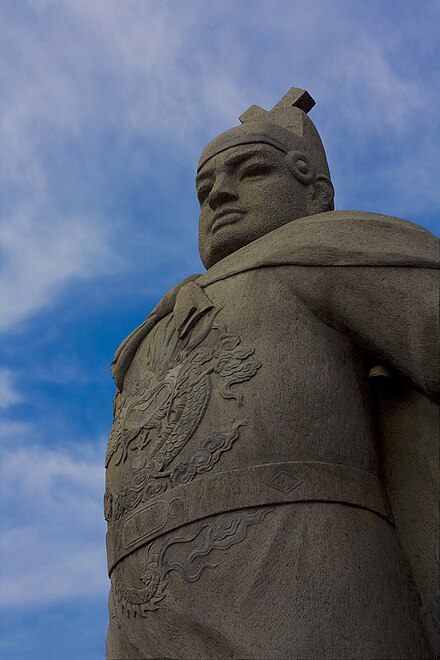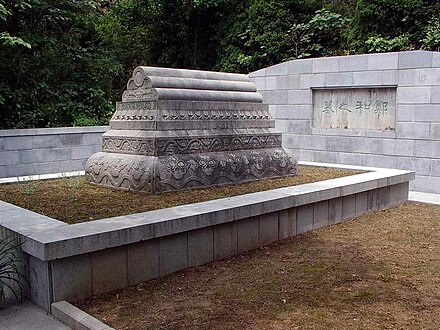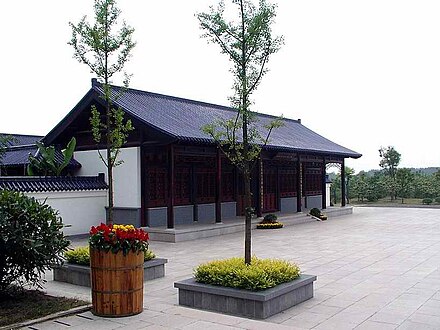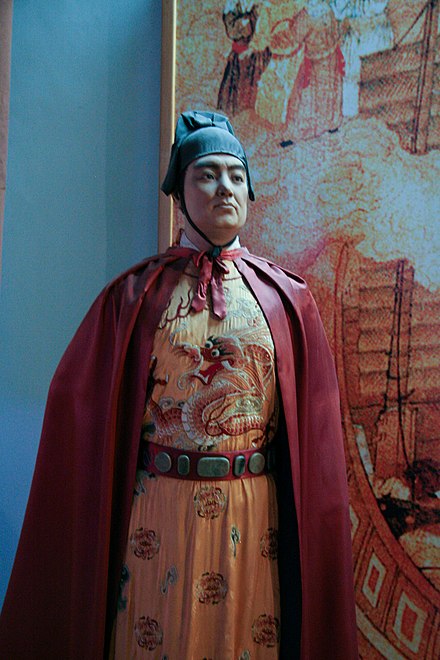Voyages of Zheng He
Voyages of Zheng He
 Admiral Zheng He (Chinese: 鄭和/郑和 Zhèng Hé), also known in English as Cheng Ho in Southeast Asia, was a Chinese mariner, explorer, diplomat, and fleet admiral early in China's Ming Dynasty.
Admiral Zheng He (Chinese: 鄭和/郑和 Zhèng Hé), also known in English as Cheng Ho in Southeast Asia, was a Chinese mariner, explorer, diplomat, and fleet admiral early in China's Ming Dynasty.
Understand
He was born as Ma He in a Muslim family, taken prisoner as a child during the Ming conquest of Yunnan and made into a court eunuch. He later adopted the surname Zheng conferred by Emperor Yongle.
Zheng He commanded expeditionary treasure voyages to Southeast Asia, the Indian Subcontinent, Western Asia, and East Africa from 1405 to 1433. According to legend, his larger ships carried hundreds of sailors on four decks and were almost twice as long as any other wooden ship ever recorded. His voyages are the seven Ming treasure voyages undertaken.
The China National Space Administration has named its proposed sample-return spacecraft ZhengHe. Its mission to explore Near-Earth asteroid 2016 HO3 is scheduled to launch in 2024.
Expeditions
China had been trading with Arabs and all the countries between for centuries via the Maritime Silk Road, but in the 14th century the Yuan Dynasty expanded that trade and Chinese knowledge of the world. Until then "universal" maps had only displayed China and its surrounding seas, but now they began to include more accurate depictions of the extent of India, Arabia and Africa.
Between 1405 and 1433, the Ming Dynasty sponsored seven naval expeditions. The Yongle Emperor designed them to establish a Chinese presence and impose imperial control over the Indian Ocean trade, impress foreign peoples in the Indian Ocean basin, and extend the empire's tributary system. Zheng He was placed as the admiral in control of the huge fleet and armed forces that undertook these expeditions. Wang Jinghong was appointed his second in command. Preparations were thorough and wide-ranging, including the use of so many linguists that a foreign language institute was established at Nanjing. Zheng He's first voyage departed 11 July 1405, from Suzhou, and consisted of a fleet of 317 ships holding almost 28,000 crewmen.
Zheng He's fleets visited Brunei, Java, Thailand and Southeast Asia, India, the Horn of Africa, and Arabia, dispensing and receiving goods along the way. Zheng He presented gifts of gold, silver, porcelain, and silk; in return, China received such novelties as ostriches, zebras, camels, and ivory from the Swahili. The giraffe he brought back from Malindi was considered to be a qilin and taken as proof of the favor of heaven upon the administration. The Daxuexi Alley Mosque in Xi'an has a stele dating to January 1523, inscribed with Zheng He's the fourth maritime voyage to Tianfang, Arabian peninsula.
While Zheng He's fleet was unprecedented, the routes were not; there had been trade between China and the Arabian peninsula since at least the Han Dynasty (206 BCE to 220 CE). See Maritime Silk Road.
Zheng He generally sought to attain his goals through diplomacy, and his large army awed most would-be enemies into submission. But a contemporary reported that Zheng He "walked like a tiger" and did not shrink from violence when he considered it necessary to impress foreign peoples with China's military might. He ruthlessly suppressed pirates who had long plagued Chinese and southeast Asian waters. He also waged a land war against the Kingdom of Kotte on Ceylon, and he made displays of military force when local officials threatened his fleet in Arabia and East Africa. From his fourth voyage, he brought envoys from 30 states who traveled to China and paid their respects at the Ming court.
In 1424, the Yongle Emperor died. His successor, the Hongxi Emperor (r. 1424–1425), stopped the voyages during his short reign. Zheng He made one more voyage during the reign of Hongxi's son, the Xuande Emperor (r. 1426–1435); the emperor allowed the old man to make the Hajj pilgrimage to Mecca.
After that, the voyages of the Chinese treasure ship fleets were ended. Xuande believed his father's decision to halt the voyages had been meritorious and thus "there would be no need to make a detailed description of his grandfather's sending Zheng He to the Western Ocean". The voyages "were contrary to the rules stipulated in the Huang Ming Zuxun" (皇明祖訓), the dynastic foundation documents laid down by the Hongwu Emperor. They further violated longstanding Confucian principles. Upon Zheng He's death and his faction's fall from power, his successors sought to minimize him in official accounts, along with continuing attempts to destroy all records related to the Jianwen Emperor or the manhunt to find him.
Although unmentioned in the official dynastic histories, Zheng He probably died during the treasure fleet's last voyage. Although he has a tomb in China, it is empty: he was buried at sea.
Zheng He led seven expeditions to the "Western" or Indian Ocean. Zheng He brought back to China many trophies and envoys from more than 30 kingdoms – including King Vira Alakeshwara of Ceylon, who came to China as a captive to apologize to the Emperor for offenses against his mission.
See
Nanjing, China
- Zheng He Park (or Taiping Park), at No. 35 Taiping Lane, is the original site of the private garden of Zheng He’s mansion when he was the garrison officer of Nanjing. Built in 1953, Zheng He Park includes Memorial Hall of Zheng He, the earliest one in China, and the Shuangbao Pavilion in the ancient style.
- Jinghai Temple is southwest of Lion Mountain. To reward Zheng He, Emperor Zhu Di ordered the construction of this temple. “Jinghai” means peace and calmness. Zheng He over in the temple's 80 rooms and halls in his later years, and it was here he placed some of the treasures he brought back from his many voyages.
- Tianfei Palace (天妃宫; Tiānfēigōng; 'Palace of the Celestial Wife') in the northern part of Jianning Road, at the foot of Lion Mountain, outside the Yifeng Gate in Xiaguan District. Zheng He built this temple in honor of the goddess Mazu, after the fleet returned from its first western voyage in 1407. To celebrate the 600th anniversary of Zheng He’s voyages, Tianfei Palace was rebuilt on the same site.

- Zheng He's Tomb in the southern edge of Niushou Mountain has been repaired and a small museum built next to it, although his body was buried at sea off the Malabar Coast in western India. It was built to commemorate the 580th anniversary of his voyages. In front of the tomb are 28 steps divided into four groups and seven layers, representing Zheng He’s seven voyages which lasted for 28 years. His sword and other personal possessions were interred in a Muslim tomb inscribed in Arabic. The tomb of Zheng He's assistant Hong Bao had been unearthed in Nanjing, as well.

- Zheng He Treasure Ship Park, in Zhongbao Village in the Gulou District, on the bank of Yangtze River, west of Nanjing. It is a large series of ruins built by the Nanjing government to commemorate the 600th anniversary of Zheng He’s voyages. The park includes the Memorial Archway, Zheng He Bell, Museum Square, the Museum of Treasure Ships (bao chuan), the Watchtower, the Ancient Shipyard, and the Treasure Sailing Vessel.
- Jingjue Mosque: Standing near Sanshan Street, south of Nanjing, Jingjue Mosque is the largest mosque in Nanjing. It is the most famous mosque in China’s South-East coastal area, and is listed as one of the eight famous ancient mosques of China. Jingjue Mosque was first built in 1388 on the orders of Emperor Zhu Yuanzhang. In 1430, the mosque was destroyed by fire, and Emperor Xuande rebuilt it at the request of Zheng He. Its reconstruction was extensive and elaborate, and today it is one of the best preserved ancient mosques related to Zheng He.
Elsewhere in China
- The "Deed of Foreign Connection and Exchange" (通番事跡) or "Tongfan Deed Stele" is a reconstruction in the Tianfei Palace in Liuhe, Taicang (near Suzhou, whence his expeditions departed. The stele was submerged and lost.
- In order to thank the Celestial Wife for her blessings, Zheng He and his colleagues rebuilt the Tianfei Palace in Nanshan, Changle county, in Fujian province prior to departing on their last voyage. At the renovated temple, they raised a stele entitled "A Record of Tianfei Showing Her Presence and Power", discussing their earlier voyages.
- Underwater World, Beihai. It has a large section on China's naval history, with some nods to foreign expeditions as well. Of particular interest is the exhibit on the Admiral Zheng He, including a detailed comparison between his massive treasure ships and the comparatively tiny vessels of Christopher Columbus.
- Kunyang, near Jianshui. Zheng He is honored in his hometown by a parkful of monuments, Zheng He Park, on top of Kunyang's Moon Mountain (Yue Shan).
- Daxuexi Alley Mosque (94 Daxuexi Alley, Zhong Lou Shang Quan, Lianhu Qu, Xian Shi, Shaanxi Sheng) in Xi'an. It has a stele dating to January 1523, inscribed with Zheng He's the fourth maritime voyage to Tianfang, Arabian peninsula.

- Quanzhou Maritime Museum (Chinese: 泉州海外交通史博物馆), In the Fengze District of Quanzhou, Fujian. 2020-05-15
Outside of China
- National Museum of Colombo, Sri Lanka. The Galle Trilingual Inscription is a stele inscribed in three languages: Chinese, Tamil and Persian. The inscription praises Buddha and describes the fleet's donations to the famous Tenavarai Nayanar temple of Tondeswaram frequented by Hindus and Buddhists. 2020-05-13
- Malacca, Malaysia — Zheng He's arrival in Malacca resulted in the Malacca Sultanate establishing a tributary relationship with the Ming, and also led to one of the earliest waves of Chinese immigration to the region. Many of these Chinese settlers married the local Malays and gave rise to the Peranakan community, whose unique culture endures to this day. The Cheng Ho Cultural Museum, which was built on the site of Zheng He's warehouse, can be visited by people interested to learn the history. Zheng He and his men built their Southeast Asian base in the area known as Bukit Cina, where they dug seven Dragon Wells, three of which survive and have never dried even in the worst droughts. You can also visit the Baba & Nyonya Heritage Museum, which used to be the home of a wealthy Peranakan family, and also sample the distinctive Pernakan cuisine while in the city.
- Benteng Heritage Museum, Tangerang, Java, Indonesia, -6.17870°, 106.62969°, +62 21 55791139. Museum on the history of Chinese settlement in Tangerang and Indonesia, and the importance of the voyages of Chinese admiral Zheng He in spreading Chinese heritage across (Southeast) Asia. 2016-09-16